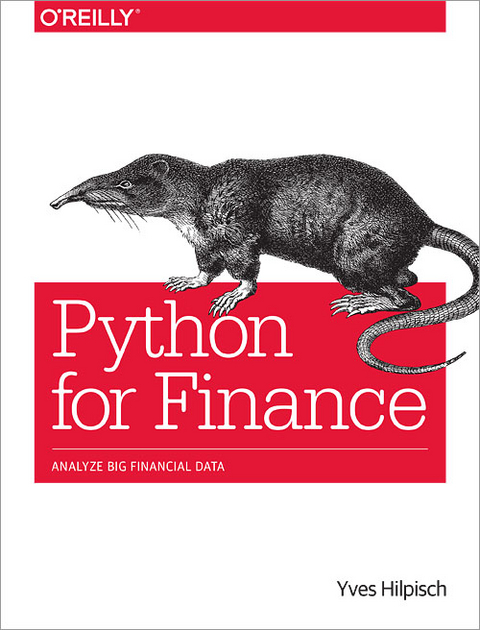
Python for Finance
O'Reilly Media (Verlag)
978-1-4919-4528-5 (ISBN)
- Titel ist leider vergriffen;
keine Neuauflage - Artikel merken
Using practical examples through the book, author Yves Hilpisch also shows you how to develop a full-fledged framework for Monte Carlo simulation-based derivatives and risk analytics, based on a large, realistic case study. Much of the book uses interactive IPython Notebooks, with topics that include:
- Fundamentals: Python data structures, NumPy array handling, time series analysis with pandas, visualization with matplotlib, high performance I/O operations with PyTables, date/time information handling, and selected best practices
- Financial topics: mathematical techniques with NumPy, SciPy and SymPy such as regression and optimization; stochastics for Monte Carlo simulation, Value-at-Risk, and Credit-Value-at-Risk calculations; statistics for normality tests, mean-variance portfolio optimization, principal component analysis (PCA), and Bayesian regression
- Special topics: performance Python for financial algorithms, such as vectorization and parallelization, integrating Python with Excel, and building financial applications based on Web technologies
Yves Hilpisch has 10 years of experience with Python, particularly in the finance space. He founded Visixion - an independent, privately-owned analytics software provider and financial engineering boutique. He works as Managing Director Europe for Continuum Analytics, and lectures on Mathematical Finance at Saarland University in Germany.
Python and Finance
Chapter 1Why Python for Finance?
What Is Python?
Technology in Finance
Python for Finance
Conclusions
Further Reading
Chapter 2Infrastructure and Tools
Python Deployment
Tools
Conclusions
Further Reading
Chapter 3Introductory Examples
Implied Volatilities
Monte Carlo Simulation
Technical Analysis
Conclusions
Further Reading
Financial Analytics and Development
Chapter 4Data Types and Structures
Basic Data Types
Basic Data Structures
NumPy Data Structures
Vectorization of Code
Conclusions
Further Reading
Chapter 5Data Visualization
Two-Dimensional Plotting
Financial Plots
3D Plotting
Conclusions
Further Reading
Chapter 6Financial Time Series
pandas Basics
Financial Data
Regression Analysis
High-Frequency Data
Conclusions
Further Reading
Chapter 7Input/Output Operations
Basic I/O with Python
I/O with pandas
Fast I/O with PyTables
Conclusions
Further Reading
Chapter 8Performance Python
Python Paradigms and Performance
Memory Layout and Performance
Parallel Computing
multiprocessing
Dynamic Compiling
Static Compiling with Cython
Generation of Random Numbers on GPUs
Conclusions
Further Reading
Chapter 9Mathematical Tools
Approximation
Convex Optimization
Integration
Symbolic Computation
Conclusions
Further Reading
Chapter 10Stochastics
Random Numbers
Simulation
Valuation
Risk Measures
Conclusions
Further Reading
Chapter 11Statistics
Normality Tests
Portfolio Optimization
Principal Component Analysis
Bayesian Regression
Conclusions
Further Reading
Chapter 12Excel Integration
Basic Spreadsheet Interaction
Scripting Excel with Python
xlwings
Conclusions
Further Reading
Chapter 13Object Orientation and Graphical User Interfaces
Object Orientation
Graphical User Interfaces
Conclusions
Further Reading
Chapter 14Web Integration
Web Basics
Web Plotting
Rapid Web Applications
Web Services
Conclusions
Further Reading
Derivatives Analytics Library
Chapter 15Valuation Framework
Fundamental Theorem of Asset Pricing
Risk-Neutral Discounting
Market Environments
Conclusions
Further Reading
Chapter 16Simulation of Financial Models
Random Number Generation
Generic Simulation Class
Geometric Brownian Motion
Jump Diffusion
Square-Root Diffusion
Conclusions
Further Reading
Chapter 17Derivatives Valuation
Generic Valuation Class
European Exercise
American Exercise
Conclusions
Further Reading
Chapter 18Portfolio Valuation
Derivatives Positions
Derivatives Portfolios
Conclusions
Further Reading
Chapter 19Volatility Options
The VSTOXX Data
Model Calibration
American Options on the VSTOXX
Conclusions
Further Reading
Appendix Selected Best Practices
Appendix Call Option Class
Appendix Dates and Times
| Erscheint lt. Verlag | 20.1.2015 |
|---|---|
| Zusatzinfo | black & white illustrations |
| Verlagsort | Sebastopol |
| Sprache | englisch |
| Maße | 188 x 231 mm |
| Gewicht | 1016 g |
| Einbandart | Paperback |
| Themenwelt | Informatik ► Datenbanken ► Data Warehouse / Data Mining |
| Informatik ► Programmiersprachen / -werkzeuge ► Python | |
| Mathematik / Informatik ► Informatik ► Web / Internet | |
| Mathematik / Informatik ► Mathematik ► Finanz- / Wirtschaftsmathematik | |
| Wirtschaft ► Betriebswirtschaft / Management ► Finanzierung | |
| Schlagworte | Finanzmathematik • Python • Wirtschaftsmathematik |
| ISBN-10 | 1-4919-4528-1 / 1491945281 |
| ISBN-13 | 978-1-4919-4528-5 / 9781491945285 |
| Zustand | Neuware |
| Haben Sie eine Frage zum Produkt? |
aus dem Bereich


